Making an application for a memo. Registration and routes of movement of notes in the organization
You can communicate with the director or with the management of another structural division of the company to the personnel officer not only personally, especially in time pressure, when a director or manager can simply forget about an employee’s appeal in the confusion. Memos can be used as a tool for interacting with management. In fact, a memo is an information and reference document containing a request or requirement and documenting the appeal to the head .
There are times when only a memo can protect against unfair claims against an employee from the management. It is not necessary to enter a separate case for registering memos in the nomenclature, you can register them as outgoing documentation. Registration of notes is very important, this is a confirmation of the fact of the relationship.
Personnel officers in the service have to interact not only with superiors, but also with all structural divisions of the company. You will not always be able to get an answer to verbal requests or wishes, and if you document and register the request, you will not only give it significance, but also be able to insure against some troubles. Memos can be written not only by personnel officers. It will be right if the personnel officer teaches the company's employees how to use this tool.
There you are real example. Your job responsibilities include work books. You don't have blank forms, but a specialist is hired who has not yet worked anywhere and a work book has not yet been issued to him. By law, within 5 days you are required to create a work book for him and issue it.
Oral requests for the purchase of forms remained unanswered, time is running out. Violation of the deadline is a violation of the terms of your employment contract, What can you get disciplinary action for?.
Exit - memo!
Purpose of the memo
Wrote a note asking for the forms, registered it - insured against discipline! The issue will be resolved as the director now has a reminder.
How to write a memo
Most often, notes are addressed to management in order to report any internal  problem. There is no unified note form, but it is compiled according to the rules. The basis of a memo can be:
problem. There is no unified note form, but it is compiled according to the rules. The basis of a memo can be:
- request;
- comment;
- sentence.
The main thing is to describe the essence of the problem, the consequences of inaction and suggest solutions. Here's how to write a memo:
Approximate content of a memo
- start with a “header” (addressee and addressee);
- name the document - "Memorandum";
- indicate the date and outgoing number;
- describe the problem;
- list possible consequences;
- offer solutions;
- subscribe.
For clarity, below is a simple memo - an example of how to write a memo correctly:
General Director of Fortuna LLC
Gorbunkov S.S.
from the head of the personnel department Lapteva M.I.I hereby inform you that the personnel department does not have any forms of work books and inserts in them. December 20, 2015 was hired by Sidorov II, who does not have a work book.
If I do not issue for Sidorov I.I. work book within 5 days, I face an administrative fine of 500 to 3000 rubles, and Fortuna LLC - from 30 to 50 thousand!
To prevent this from happening, it is necessary to purchase forms of work books and inserts in them. Forms will be needed in the future, because we are constantly hiring.
I hereby offer:
1. Purchase blank work books in the amount of 20 pieces and blank inserts in the books in the amount of 10 pieces.2. Either entrust me with the purchase of forms at my own expense, and then reimburse the amount spent on the basis of reporting documents.
Head of HR Department _________________ / M.I. Lapteva
If the company has a secretary, then the note must not only be registered in your outgoing documents, but also with the secretary:
Registration note
- prepare a note in 2 copies;
- register in your outgoing documents;
- register with the secretary (the secretary will write the date, incoming number and sign);
- We transfer one copy to the secretary, and we put the registered one in the folder of outgoing documents.
You can also serve in in electronic format send and fax. Confirmation of sending can serve as a printout electronic document, and the fax report.
External memo
 Sometimes it happens that memos act as an external document, that is, they are addressed to employees of another organization. Firms exchange information through notes.
Sometimes it happens that memos act as an external document, that is, they are addressed to employees of another organization. Firms exchange information through notes.
A personnel officer can use external correspondence, for example, when hiring an employee by transfer from another organization.
You can file a claim in the form of a memo. For example, if the stationery store did not deliver the forms of work books on time, send a service there in the form of a claim.
Service or memorandum
Internal correspondence implies the presence of several types of notes:
- official;
- reporting;
- explanatory.
It is clear that in explanatory note explanations are given on this or that fact. For example, an explanation for absenteeism or being late. And to choose which one is needed - a memorandum or a memo, the difference is not significant. But still she is.
The memorandum often describes a problem at work or some kind of violation on the part of employees. The report does not contain requests and solutions to problems. Reports are prepared in the same way as office reports. The text of the report might look like this:
I report that the system administrator Petrov A.A. every day late for work for 1-2 hours.
Just do not take this text of the report as a "mortgage". In the end, late Petrov A.A. will cause financial harm to the company and they can ask from the one who did not warn the management.
Registration of documents
A report, like a memo, is a document that requires registration. Although it is not written in any legal act, insure - register all possible outgoing documents!

Functions and purpose
A memo is a form of internal correspondence and, depending on the content, may be of an informational, proactive or reporting nature. It sets out the business positions of an independent unit or leader on any issue. A memo may contain suggestions or requests and be addressed to any leading person, including a superior.
Signing and registration
Memos are signed by the direct head of the unit. In the lower part of the left corner, the performer must endorse it. His name and contact number are also written there.
In structural divisions, memos are registered in the program electronic document management. They are assigned a number, sent to the units in paper form and on electronic media. The numbering consists of the subdivision index and the registration number.
The date of the service note is the moment of its registration. Its original with the resolution of the leading person is sent to the head. A copy of the memo is returned to the contractor.
Variety of memos
A memo is a kind of memo addressed to the direct supervisor. is drawn up when it is necessary to reflect the opinion of a unit or manager on a specific issue and give specific proposals.
Depending on the purpose and content, memos can be initiative (in the form of comments and suggestions) or reporting (on the results of the audit, on a business trip).
The date or period of time to which the information recorded in the memorandum relates must be highlighted on a separate line, included in the heading or at the beginning of the text. The memorandum is signed by the author-compiler.
The text part of the memo and memorandum is recommended to be composed of 2 parts. The first part of it should consist of the facts that gave rise to its writing, and the second part should consist of proposals and corresponding conclusions on the issue being presented.
Each developed document can contain only one question. The exceptions are protocols, orders, plans, reports and summarizing documents.
The memo should include substantiated information presented objectively, concisely, competently, clearly and without unnecessary repetition. The text part is drawn up in the form of a solid text, a table, a questionnaire, or a combination of these forms.
The complex continuous text of any document should consist of logically and grammatically consistent information about actions in management, which are reflected in the relevant provisions, norms, rules and administrative documents.
A service note must have the required details and an invariable order of placement: the author, the name of the enterprise and its code, index, date, heading, body text, visas, the signature of the performer, a mark of completion and sending the document to the case.
The title of the memo should be brief. If the document deals with several problems, then the heading can be generalized.
Addressing rules
Memos are addressed to organizations, departments or a specific manager within the enterprise. In a document addressed to many homogeneous organizations, the addressee is indicated in a generalized way. A memo should not have more than 4 recipients.
Conclusion
All outgoing information in the scope of a memo should be provided upon request and sent only officially. The information provided must be signed and endorsed by the head whose area of activity it affects.
All memos must be dated. The date of the document and any service marks on it are an indispensable attribute of any document.
Almost all important things people do by correspondence;
therefore, the ability to speak alone is not enough.
Luc de Vauvenargues
Let's talk about a memo as the main means of internal communications, a document that can streamline internal relationships, ensure the prompt exchange of information, and resolve a controversial situation.
WHY ORGANIZATIONS IGNORE MEMORIES?
The memo remains an outsider in the business correspondence of private organizations. In state organizations, on the other hand, the majority internal documents These are memos.
Often in commercial organizations, a memo is treated as a meaningless formality, however, this element of internal corporate document management, as an integral part corporate culture, has invaluable potential for business development.
What is the basis for the sharply negative attitude of a number of managers of the linear level of commercial organizations to one of the most important internal documents that serves as the basis for making managerial decisions? Possible reasons:
Low culture business communication, lack of corporate standards, strong-willed management decisions in the field of internal document management;
Lack of official status, since the memo is not included in the classifier of management documentation;
Availability of electronic means of communication. Managers do not want to spend time formalizing management processes, preferring to exchange a few words in person, call mobile phone, write to email or Skype, etc.
But there is another reason: sometimes managers sabotage the formalization of the system of internal documents. It is difficult to refute documented information about the state of affairs in the organization, instructions addressed to an official or, say, instructions on the procedure for actions in specific situations. Working in chaos has certain advantages: there is nothing easier than to refuse the fact of the transmission of oral information, as well as instructions given tête-à-tête. Everyone is familiar with the situation when an employee regularly receives orally mutually exclusive instructions, failure to comply with any of which entails administrative sanctions.
WHAT IS THE USE OF MEMORIES?
Memo is internal business letter, with which you can quickly and efficiently solve current production issues.
The main purpose of a memo is the exchange of official information between employees of the same organization who are equal in official status.
The purposes of compiling memos can be different:
Horizontal communications of heads of structural divisions / officials in solving common production issues and problems;
Effective communication:
Exchange of operational information between structural/independent subdivisions and branches;
Request for reference information;
Conducting training;
Accompanying another message (accompanying note);
Solving current issues of administrative, economic, logistical, informational and other support;
Resolution of disputable and conflict situations.
The ability to competently draw up internal documents, including memos, helps out in extremely complex and confusing situations.
First of all, a memo is the main assistant for employees of the document management service (hereinafter - DOW) in controversial situations.
Unfortunately, the heads of the main structural divisions often try to write off the shortcomings of the division when working with documents on the employees of the auxiliary divisions. For example, the management of the structural unit did not fulfill the instructions of the superior manager on time, but the responsibility for this shifts to the service of the preschool educational institution, which allegedly delayed sending the outgoing letter.
A memo will help refute baseless accusations. A note that contains the facts, deadline, full name. employees of the preschool educational institution who completed the work in a quality and timely manner, with confirmation applications (copies of registration cards, excerpts from registration logs, etc.), often helps to maintain objectivity, recognize the claim as unfounded, restore the business reputation of a particular employee and the preschool service as a whole (Example one).

The text of the memo must clearly state the purpose of the message in an accessible and concise manner. Incomplete or redundant information makes it difficult for the addressee to understand the essence of the problem and may lead to ambiguous interpretation and, as a result, the absence of the desired result. The effectiveness of a memo depends on how well the structure of the document is built and whether the arguments are logical.
WE ISSUING A MEMO
IF ON THE FORM, THEN WHAT?
Service notes are usually clean slate A4 size paper. However commercial organizations for this purpose, a letter form is often used, which, according to clause 4.7 of GOST R 6.30-2003 “Unified Documentation Systems. Unified system of organizational and administrative documentation. Requirements for paperwork" contains:
The emblem of the organization or trademark (service mark);
Name of company;
Organization code;
The main state registration number (OGRN) of a legal entity;
Taxpayer identification number/registration reason code (TIN/KPP);
Reference data about the organization;
The place where the document was compiled or published.
In addition, some experts on the pages of magazines and on the Internet cite as an example samples of memos drawn up on letterhead.
Undoubtedly, it is easier to draw up all documents indiscriminately on the same form. However, writing a memo to the head of the neighboring department on a form that contains reference data, TIN, PSRN, etc., does not make sense. In addition, the letterhead of the organization takes up at least 20 percent of the total volume of the first page, and often the necessary information does not fit on one sheet. It seems like a small thing, but in a large organization, such small things lead to wasted spending, not cost savings.
Find out on what form you can draw up a memo (if desired).
Types of document forms are established in clause 4.6 of GOST R 6.30-2003.

Meanwhile, GOST R 7.0.97-2016 “System of standards for information, librarianship and publishing. Organizational and administrative documentation. Documentation requirements”, which comes into force on July 1, 2018, already contains clarifications on the organization’s forms (clauses 5.8 and 6.6).
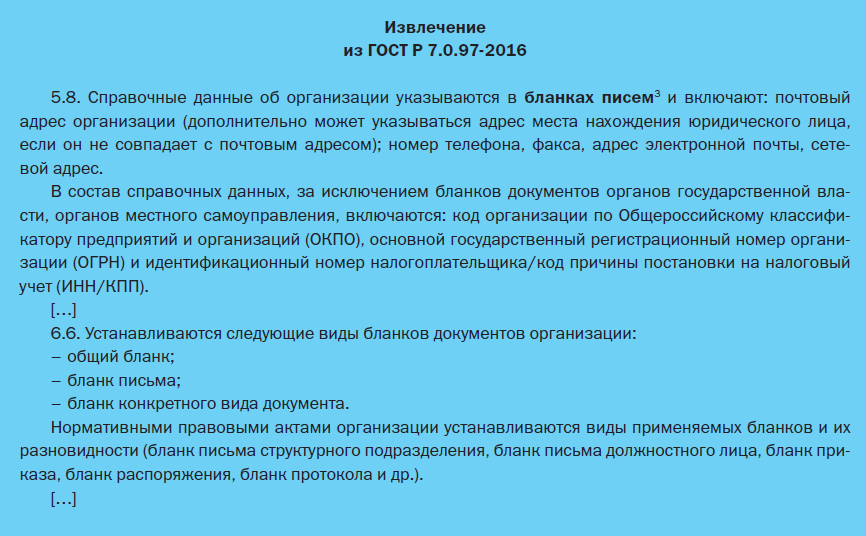
It follows from this that the standards do not recommend issuing a memo on letterhead. But if the desire to conduct internal correspondence without fail on the form is great, it is possible to develop and fix in the LNA a form for a specific type of document - a memo.

FORM OF MEMO: DETAILS
In accordance with GOST R 6.30-2003, the following details must be included in the form of a specific type of document (in our case, a memo) (Example 2):
03 - "Organization emblem or trademark (service mark)";
08 - "Name of organization";
10 - "Name of the type of document";
11 - "Document date";
12 - " Registration number document";
14 - "Place of compilation or publication of the document";
15 - "Address" (name of the structural unit and position of the employee to whom the memo is sent);
18 - "Heading to the text";
20 - "Text of the document";
21 - "Mark of the presence of the application";
22 - "Signature";
27 - "Note about the performer."
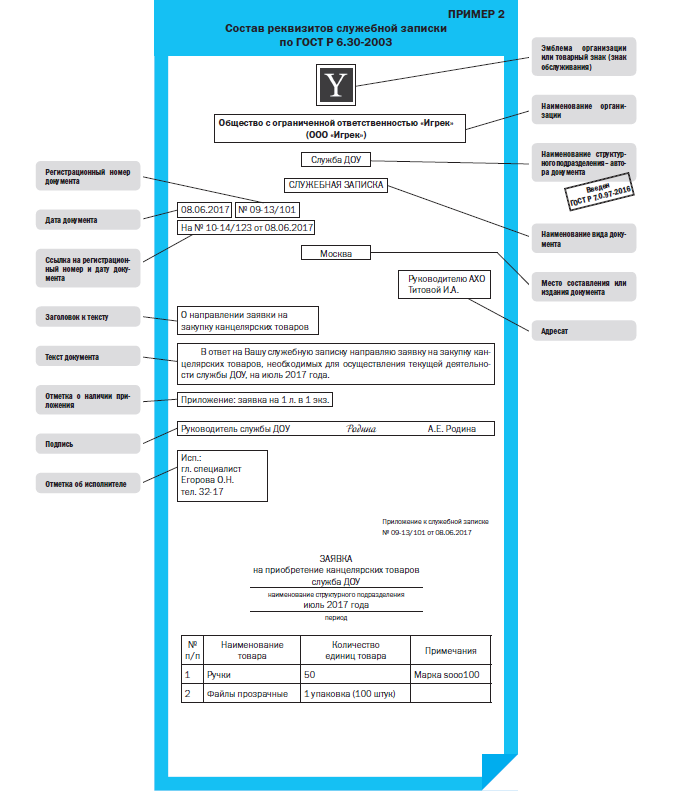
NUANCES OF REGISTRATION OF DETAILS
- "Destination". If the note is sent to several structural subdivisions, the “Addressee” requisite is drawn up in the upper right corner as follows:
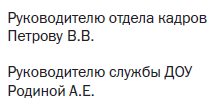
If the total number of recipients is more than four, a mailing list must be created.
- "Document Text". A memo, like a business letter, must be clearly structured. The text of the memo is written in the first person singular(“I ask you to list”, “I consider it necessary”, etc.).
The text, divided into logically complete paragraphs, makes it easier to read and understand, gives each thought a logical completeness, and allows the addressee to better navigate the text of the document.
The text of a memo, as a rule, consists of:
From the preamble (introductory part);
main part;
The final part (conclusions, suggestions, requests, etc.).
The preamble reveals the purpose of writing the memo, contains references to the dates, documents and facts that gave rise to its compilation. The information contained in the preamble may be brief or extended. The preamble smoothly leads to the main part.
The size of the body varies depending on the purpose of the memo, and can be a few lines or a few pages of printed text.
The main goal of the main part is to explain, convince, induce to action, that is, to achieve a result. It is this part of the text that most fully reveals the content of the memo. The main part includes the largest number actual material which should not only inform, but also convince. Applications, if any, should also be mentioned there.
The final, or summarizing, part of the memo is a kind of summary that confirms the above, contains conclusions, requests, specific proposals for resolving the issue. The clearer and clearer the wording of the summary is, the more likely it is that decisions on issues will be made in a timely manner.

REGISTRATION AND ROUTES OF MOVEMENT OF NOTES IN THE ORGANIZATION
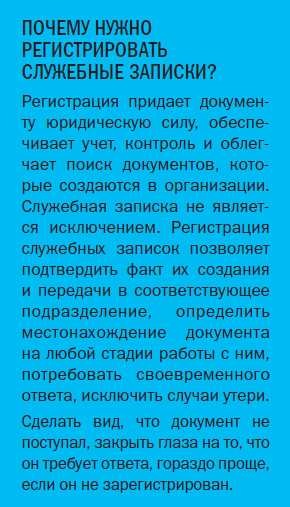
Issues of registration and subsequent transfer to the addressee of memos often cause controversy. Who should register memos? DOW service? Structural units? Secretaries? And do they need to be registered? Who and how should transfer memos so that they reach interested officials in a timely manner?
Undoubtedly, the solution of these issues is the prerogative of the organization itself, in the instructions for the office work of which there should be a section devoted to working with internal documents. The rules established in the LNA and the procedure for their actions will help to avoid disagreements.
What to do, if similar document No? Of course, to create it by formalizing the procedure for compiling, processing, and moving internal official documents. Formalization helps streamline many business processes, which has a very positive effect on general order In the organisation.
It is necessary to start work with an analysis of the flow of memos: determine its volumes and routes, eliminating obviously unnecessary segments along the document's path. To determine the most efficient document route, do not be afraid to break old, inconvenient structures, correct and correct errors in logistics.
There can be several options for routing memos - with the participation of the DOW service (Scheme 1) and without it (Scheme 2). Let's find out which of these schemes is the most effective.

INEFFICIENT REGISTRATION SCHEMES AND ROUTE OF NOTES
- Registration in the DOW service of a large organization. The transfer of memos to the DOW service for registration and subsequent redirection to the addressee slows down the process of communicating information and making decisions. This is especially noticeable in organizations with a large amount of workflow external and internal. Given the overall workload, not every service of the preschool educational institution can allocate an individual employee to register office, memorandum and other notes. One way or another, in the first place, urgent outgoing letters, orders, orders, incoming correspondence from higher authorities will always be registered, and memos will meekly wait in the wings.
- Registration as a secretary in a small organization. In organizations with a small document flow, memos are registered by the secretary of the head. A memo is an internal document of a horizontal orientation and cannot be intended for a higher official.
To provide information to management in business correspondence, reports, analytical and explanatory notes are used. Consequently, the secretary in the chain of acceptance and transmission of memos between officials of equal status is an extra link.
- Without registration, but with a mark of the DOW service on the transfer. If it is not customary for the organization to register memos, it does not make sense to send them to the addressee through the DOW service without registration. To transfer a note to the DOW service and receive a transfer mark, followed by the transfer of the document by the DOW service to the addressee unit and putting another mark on the transfer - all this complicates the process, takes time, and increases the time for execution of instructions.

If the organization still has a procedure for transferring memos with receiving a mark of acceptance, the recipient signs for receipt, indicates his position, date and time of receipt of the document (if necessary). The receipt mark is fixed on a copy of the service note, which is returned to the addressing unit.
The receipt mark can be replaced by the “Received” stamp, which contains fields for indicating the date of receipt, full name. and signature of the official (fig.).

Rice. The mark of receipt can be replaced by the stamp "Received"
EFFICIENT REGISTRATION SCHEMES AND ROUTE OF NOTES
- Registration in a structural unit, transfer of notes directly between units. Registration of memos in a structural unit, as well as their transfer from one structural unit to another, bypassing intermediaries (the service of a preschool educational institution or a secretary), shortens the path of the document to the addressee.
If the structural subdivision does not have the position of a clerk (secretary of a department/department/department), for the registration of documents, including internal ones, it is necessary to appoint an official responsible for office work. Responsible for office work is determined by the heads of structural divisions. As a rule, they appoint an employee who is not burdened official duties. The assignment of additional functions is approved by order or order and recorded in job descriptions.
- Registration of outgoing notes. The official responsible for office work in the structural unit registers the outgoing memo.
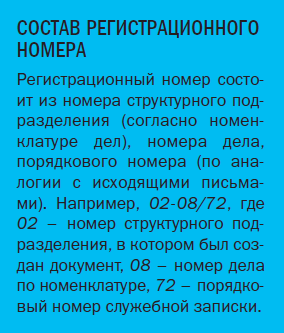
Outgoing memos are registered in the journal of internal (outgoing) correspondence of the unit (Example 3). When registering outgoing memos, the following is indicated:
Registration number of the document;
Addressee (department to which the service note is sent);
Number of pages;
Availability of applications;
date of execution;
FULL NAME. the employee who prepared the memo.
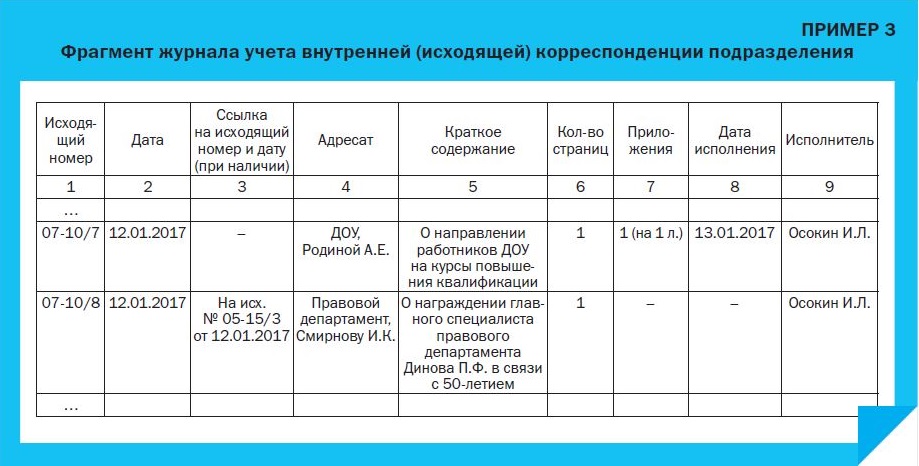
The memo can be scanned and sent by email.
If it is necessary to transfer the original, the official responsible for office work in the structural unit can draw up a schedule for the transfer of memos to addressees - once a day, 2 times a day, etc.
Urgent memos (with a clearly defined deadline) must be submitted immediately. You can transfer memos to the addressee unit directly or through cells specially equipped in the DOW service with numbers and / or names of structural units. At the same time, the DOW service does not participate in the process of transferring documents.
Registration of incoming notes. Upon receipt of a memo at the recipient unit, the official responsible for office work in the recipient unit registers it as an internal incoming document in the internal (incoming) correspondence register of the unit (Example 4) with the following details:
Incoming registration number;
Date of receipt (registration);
Number of pages;
Applications;
date of execution;
Contractor (official to whom the memo is sent).
Responsibility for compliance with the deadlines specified in the memo lies with the official to whom it is addressed. The initiator of the memo and / or a higher official can change the deadlines for the execution of the document.
- Registration by all employees. If the organization or its structural divisions do not have an employee responsible for office work, you can find other mechanisms for registering memos. For example, place a log of office memos in Word or Excel format on a server for public use. In this case, the registration of a memo by an employee of the structural unit will take no more time than the personal transfer of the document to the secretary.
However, specialists from specialized structural divisions often sabotage such proposals. Attempts to entrust them with even minor clerical operations are met with an active rebuff. To some extent, the experts are right. Remember, I.A. Krylova: “The trouble is, if the shoemaker starts the pies, and the pieman makes the boots, and things will not go smoothly”?
It is possible to avoid an open conflict with specialists of specialized departments if an appropriate order or instruction signed by the head of the organization is issued. In this case, the initiator should be the head of the preschool educational institution or another person responsible for office work. It is in his interests to remove some of the archaic functions from himself, streamline work with document flows, build effective routes for their movement, and eliminate the loss of internal documents.
As soon as such a scheme is put into effect, the dissatisfaction of employees goes down, as the registration time is significantly reduced, and the registration itself becomes transparent.

RESERVATION TERMS OF MEMORY
The terms for storing notes are contained in the List of typical managerial archival documents generated in the course of activities government agencies, organs local government and organizations, indicating the periods of storage (approved by order of the Ministry of Culture of Russia dated August 25, 2010 No. 558, as amended on February 16, 2016, hereinafter referred to as the 2010 List) (Table).
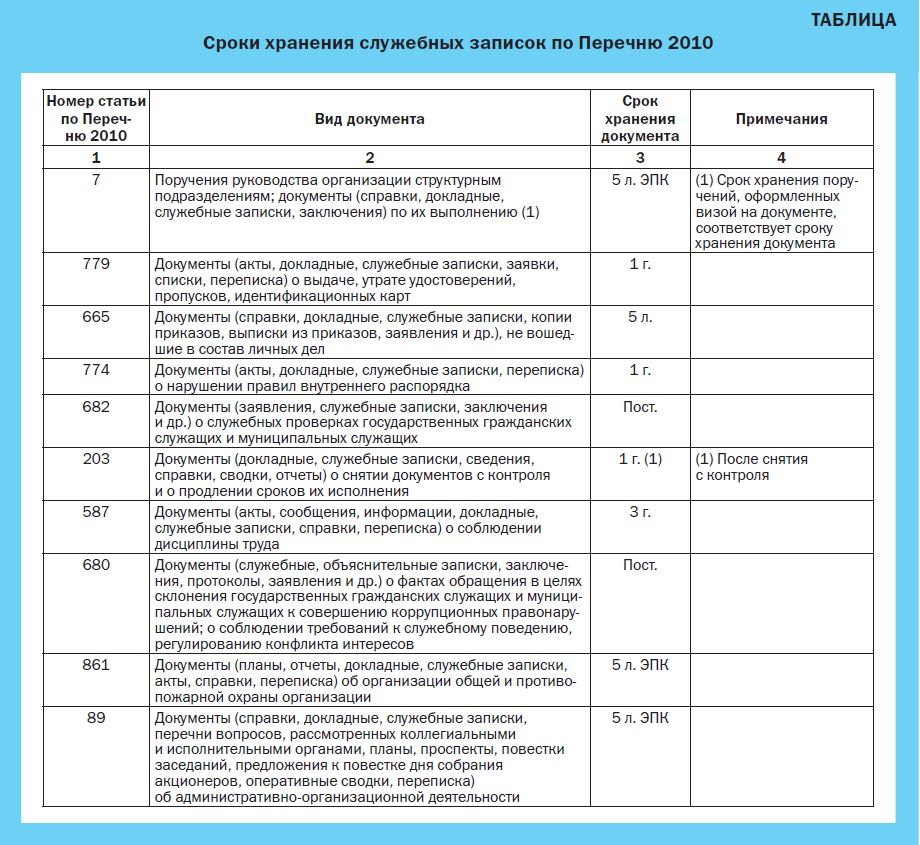
Any successfully operating organization is a living, continuously changing organism, and office work is a mirror reflection of the management system of this organism. Would you like to keep up with the times, be at the forefront? Try to start with memos - this will be the first step towards a well-organized workflow, and the verified logistics of the routes of internal documents will be the first step in the fight against managerial chaos. Examples of memos are given below (Examples 5-10).
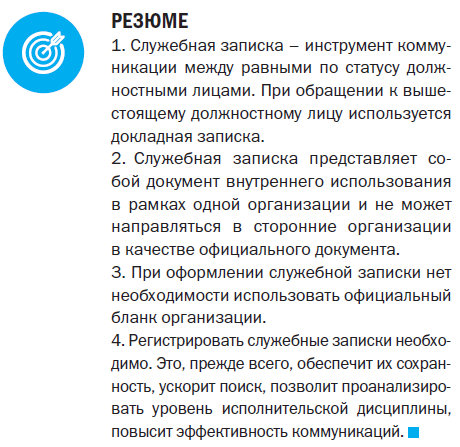
EXAMPLES OF MEMORIES
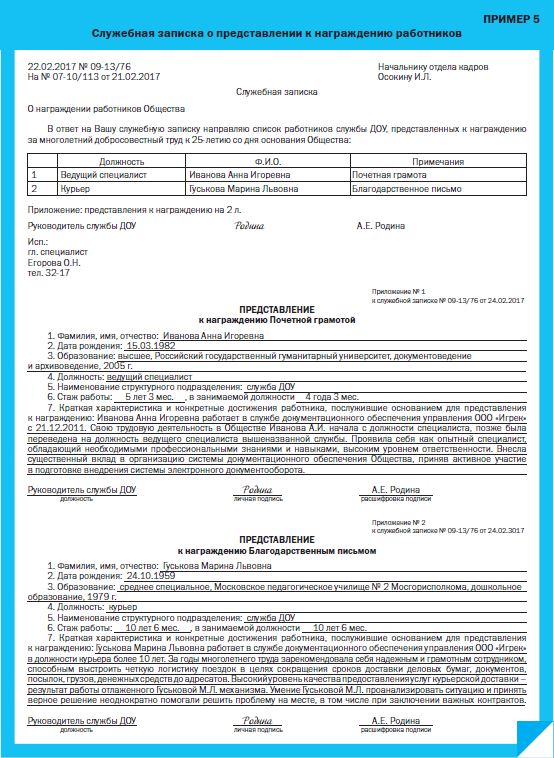


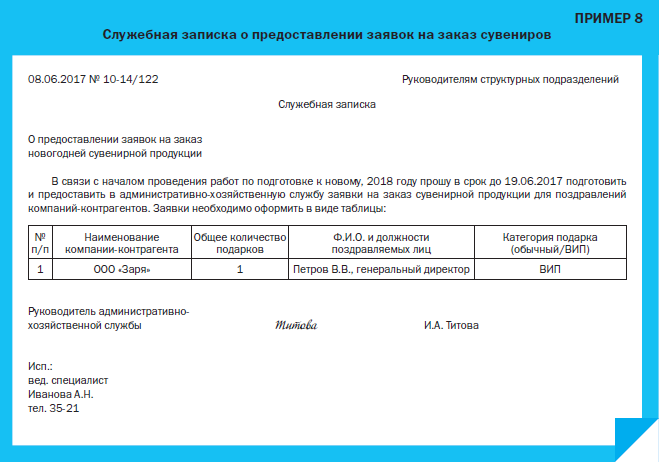
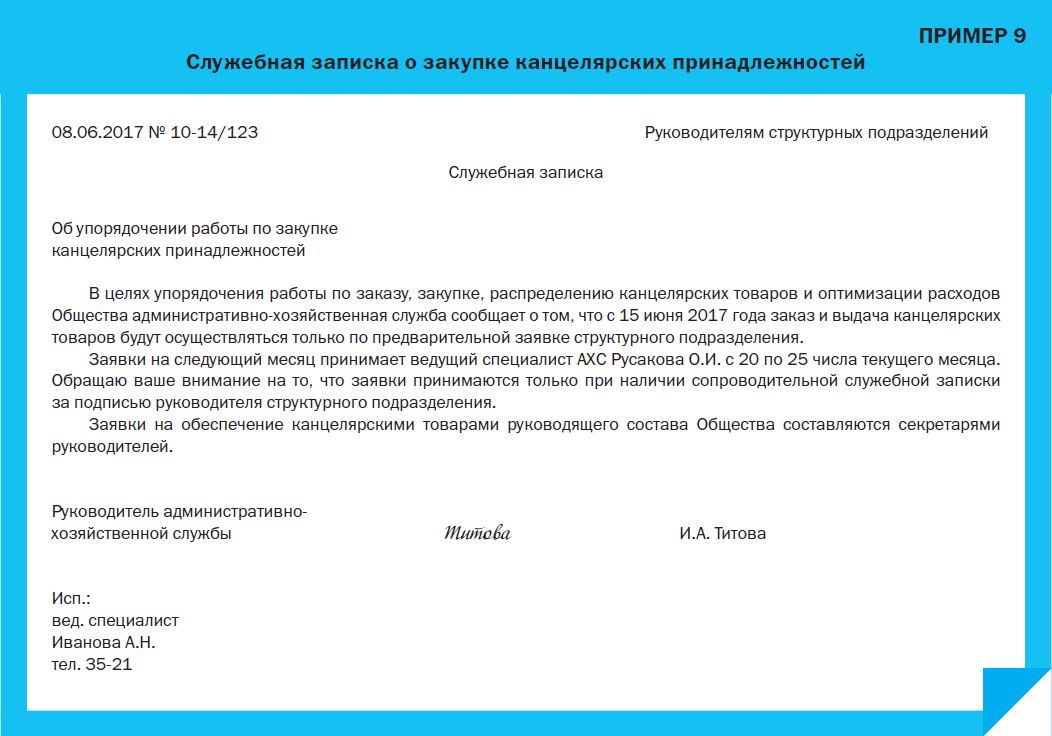
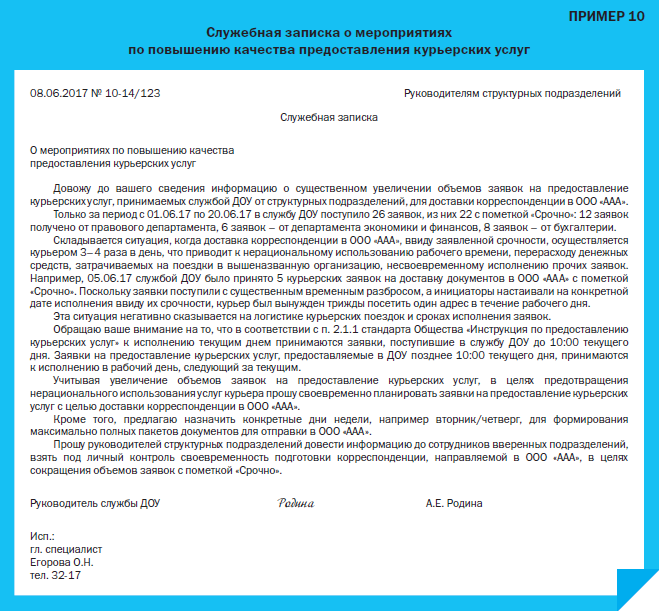
- Burns, Robert - short biography
- The concept of common vocabulary and vocabulary of limited use
- Nancy Drew: The Captive Curse Walkthrough Nancy Drew Curse of Blackmoore Manor Walkthrough
- Deadpool - Troubleshooting
- Won't start How to Survive?
- What to do if bioshock infinite won't start
- Walkthrough Nancy Drew: Alibi in Ashes
- Spec Ops: The Line - game review, review Spec ops the line crashes on missions
- Room escape level 1 walkthrough
- Processing tomatoes with boric acid How much will 2 grams of boric acid
- Cucumber Grass (Borago)
- Bioinsecticide Lepidocid: purpose, properties and application procedure Lepidocide waiting period
- How to change the language to Russian in steam
- Dendrobium noble: room care
- Morphology of plants general concepts - document
- Planting, propagation and care of bamboo at home, photo Growing bamboo from seeds
- How to strengthen the cellular signal for the Internet in the country
- Sanskrit reveals the forgotten meaning of Russian words (2 photos)
- The oldest language Sanskrit programming language of the future Dead language Sanskrit
- Who has dominion over all the earth?









